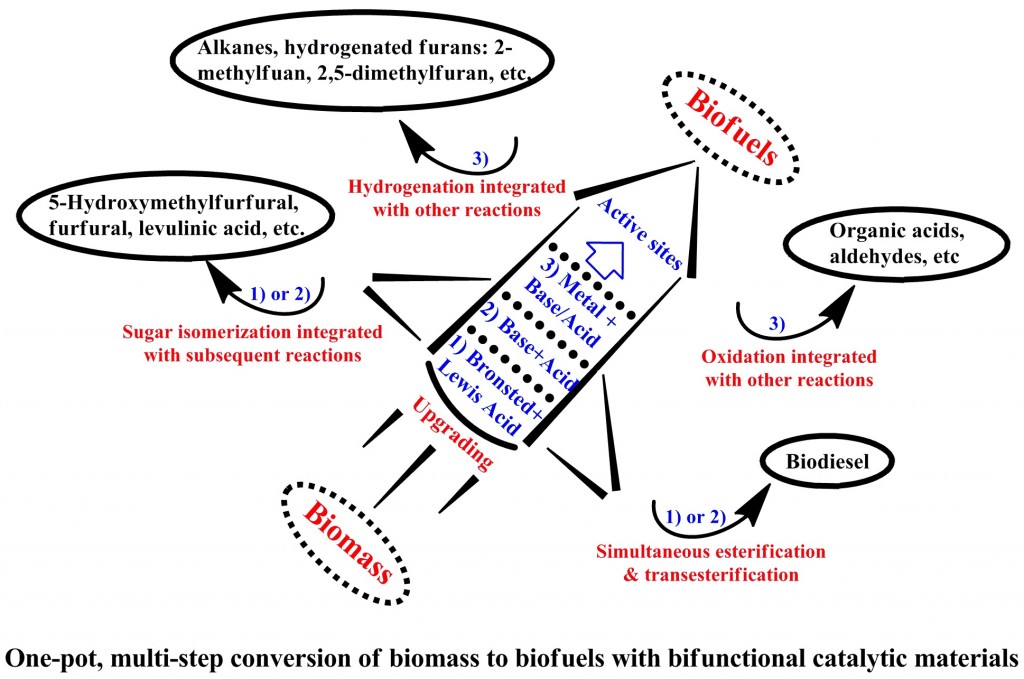Efficient valorization of biomass to biofuels with bifunctional solid catalytic materials
星期一, 18 7 月, 2016Efficient valorization of biomass to biofuels with bifunctional solid catalytic materials

Catalytic transformation of biomass sources into biofuels and value-added chemicals generally involves multi-step reaction processes, as well as difficulty in product separation and purification. In recent years, bifunctional catalytic materials have been demonstrated to be capable of catalyzing various domino/cascade- and tandem/sequential-type reactions in a single pot, thus realizing the direct and highly efficient conversion of upstream biomass molecules to target compounds.
Dr. Hu Li, a postdoctoral student, supervised by Profs. Song Yang (Guizhou university), RL Smith (Tohoku university, Japan) and Zhen Fang reviewed a series of bifunctional materials being used in one-pot multiple transformations of biomass into biofuels and related chemicals. Emphasis is placed on the assessment of the bifunctionality of catalytic materials, including Bronsted-Lewis acid, acid-base, and metal particles–acid or base bifunctional catalysts with some discussion being on combined catalytic systems with electrochemical, chemoenzymatic and photochemical methods. Plausible reaction mechanisms for key pathways are shown. Meanwhile, relevant auxiliaries to boost catalytic activity and product selectivity, such as reaction media, heating modes and morphological properties of the catalytic materials are analyzed. Use of appropriate bifunctional catalytic materials provides many opportunities for design of highly efficient reaction systems and simplified processing to produce biofuels and chemicals from lignocellulosic biomass.
The study was published:
H Li, Zhen Fang*, RL Smith Jr., S Yang, Efficient Valorization of Biomass to Biofuels with Bifunctional Solid Catalytic Materials, Progress in Energy and Combustion Science, 55: 98-194 (2016).
The paper is in “Altmetrics – Top Rated Articles”
——————————————————————–
双功能固体材料催化生物质高值转化为生物燃料
生物质资源催化转化为液体燃料和高附加值化学品通常会经历多步反应历程,且往往涉及产物难分离、纯化等问题。近年来,双功能催化材料被证实能“一锅法”催化多种串联或级联反应,实现生物质上游分子直接、高效地催化转化为目标化合物。
生物能源组博士后李虎在杨松教授(贵州大学),RL Smith教授(日本东北大学)和方真教授的指导下,综述了一系列双功能催化材料在一锅、多步催化生物质转化为生物燃料和相关化学品中的应用情况,并重点考察了固体材料的双功能活性位点(包括Bronsted-Lewis酸位点、酸-碱位点、金属-酸或碱位点等)在催化反应过程中对产物种类、选择性、产率等的调控作用。同时,也简要探讨了电化学、化学-酶、光化学等方法在协同催化生物质转化为高附加值小分子中的研究近况。针对上述催化体系,提出了可能的反应机理,并分析了反应介质、加热方式、固体材料的形貌结构等对催化性能的影响。最后,本论文展望了双功能固体材料在高效催化木质纤维素转化为特定目标产物、以及在简化或便利催化过程中潜在的研究空间和发展前景。
详情可见:
H Li, Zhen Fang*, RL Smith Jr., S Yang, Efficient Valorization of Biomass to Biofuels with Bifunctional Solid Catalytic Materials, Progress in Energy and Combustion Science, 55: 98-194 (2016).
该论文进入:”Altmetrics – Top Rated Articles”